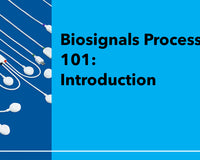Introduction
Setting up a new lab system used to be difficult and time-consuming. Not anymore! The best use of research time is doing the actual research, not just setting up for it.
This blog post simplifies the process of building your next biosignals research system, helping you focus on what truly matters—your research. We'll guide you through the key steps and offer resources to make it even easier, all with the help of our Biosignals Kit Builder.
Step 0: Define Your Research Goal Clearly
Biosignal research is exciting and it’s easy to jump into the technical aspects of new technology. First, it's important you establish a clear research goal and define what exactly do you need to measure.
For instance, if you're in sports sciences and want to measure muscle activity, you might choose an Electromyography (EMG) sensor. For more complex studies, like measuring emotional responses, careful planning is needed to select the right biosignals. If you're unsure where to start, our expert team is here to assist.
Step 1: Select Your Base System
With a clear research goal, your next step is to choose the right base system.
Your choice depends on the number of sensors you plan to use. This will help you decide whether a single-channel, 4-channel, or 8-channel system is best for your needs.

Biosignalsplux systems can be upgraded over time, as you can connect, change, and reconnect any sensor combination you would like at any time.
Pro Tip: A 4-channel system might be enough now, but an 8-channel system offers more flexibility as your research expands.
Step 2: Selecting Your Sensors
This is where it gets exciting: picking your sensors!

Depending on your base system, choose from up to 20 sensors. Don’t worry, the process is simpler than it seems.
Select the sensors that match your research needs in the quantities you require. Our Kit Builder only shows you sensors that are compatible with the selected base system. They all come with all the accessories needed to work, giving you one less thing to worry about.
Pro Tip: If you're working in unpredictable environments or with beginners, consider extra sensors to cover accidents which can cause delays.
Step 3: Select Your Software - DiY or Ready-To-Use Reports?
You can access our base software for signal recording and visualization, which is available for free. You only need to choose whether you want to develop your signal-processing software or prefer to have all the key parameters with a simple click of a button.
If you are of the latter type, add all the signal processing add-ons you need for your sensors, such as our Heart Rate Variability (HRV) add-on for cardiac sensors or Electromyography (EMG) Analysis add-on for muscle activity analysis.

No need to worry if you’re on a tight on budget or prefer full control of your biosignal processing, you can also use our free developer tools to build your own signal-processing software. We also suggest free open-source biosignals projects that fit nicely into your DiY signal processing.
Step 4: Ensure You Have Enough Consumables
Now that you’re close to getting your new biosignals tech, it’s important to get everything needed to keep your project running!
Remember to add extra consumables, mainly electrodes, enough to allow uninterrupted signal recordings throughout your research project.
Unsure about how many consumables you need? Here’s a simple guide:
- Count the number of electrodes you need per sensor in each recording (for example, an ECG sensor requires 3 per recording).
- Count the number of recordings you intend to conduct and multiply by the results of step 1.
- Add an extra 20-30% to cover testing and unexpected needs.
Start Building Your Biosignals Lab Today
You’re now ready to start your research with your new biosignals kit.
Try out our biosignals Kit Builder and set up your kit as fast as in 2 minutes.









